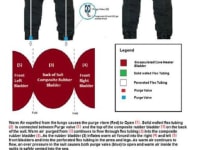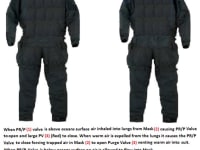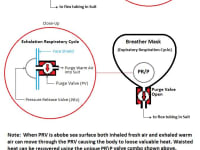
This innovation successfully merges two existing technologies (Dry Snorkel and Cold Immersion Suit technologies), to produce a new product that helps prevent hypothermia at sea. During normal breathing or respiration a human inhales fresh air into their lungs and exhales CO2 at an approximate body temperature of 98.60F. If the outside water temperature is much colder then the body it causes the core body temperature to drop and hypothermia can quickly set in. Existing Cold Immersion Suits on the market only insulate the body against the cold and can result in catastrophic loss of life during prolonged periods at sea. A mechanism to recover warm air expelled from the lungs and re-circulate it in a survival suit is given here. At the heart of the suit is the Warm Air Recovery System which relies on a single large Purge Valve (PV) to operate. The PV has a thin membrane which is normally closed and acts as a one way check valve. When warm air is expelled from the lungs it causes the Purge Valve to Open. Air forced from the Purge Valve fills a thin rubber body core heating bladder forcing air through perforated flex tubing thereby providing warmth to the torso, legs and arms. A slight positive over pressure in the suit causes warm waist air to be safety vented into the sea through two large Purge Valves (Blue) located at the bottom of the legs.
A Dry snorkel provides a mechanism that prevents water from entering the snorkel. The dry snorkel used here employs a specific type of Pressure Release Valve (PRV) a type of surface air valve that closes when submerged and opens when the snorkel is above the ocean’s surface. This PRV has the advantage of not allowing any water to enter the snorkel, while submerged in any position even upside down. Dry Snorkels also incorporate a Purge Valve (PV) which clears water that happens to enter the snorkel. Air forcefully expelled from the lungs causes the PV to open expelling water from the small reservoir. A dry snorkel’s PV and PRV technology can be easily integrated into Cold Immersion Suit design.
Advanced suit design includes an integral double walled polycarbonate full Face Shield with a PRV affixed to outside the face shield. The PRV is plumbed to inside of the Mask covering the nose and mouth. The Suit’s design offers several advantages, not the least of which allows the Suit’s occupant to breathe as freely as on land. Other advantages include not allowing cold water to enter the suit keeping the neck, face and body free from hazardous effects of high wind and waves.
The Dry Snorkel Cold Immersion Suit is intended to be utilized by US Navy, US Coast Guard and Coast Guard Auxiliary vessels, HH-60 Jayhawks, HH-65 Dolphin MEDEVAC Search and Rescue Crews, the Merchant Marine as well as the Commercial Fishing Industry Fleet in general. It is sincerely hoped the suit’s design will save lives in the North Atlantic and Bering Sea.
-
Awards
-
 2012 Top 100 Entries
2012 Top 100 Entries
Like this entry?
-
About the Entrant
- Name:Joel Galofaro
- Type of entry:individual
- Software used for this entry:Microsoft Office Painr
- Patent status:pending








